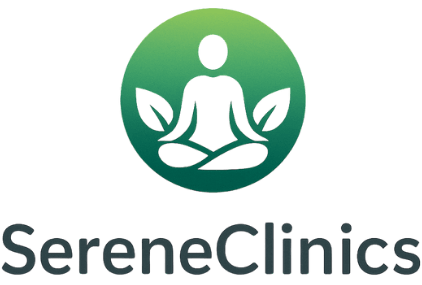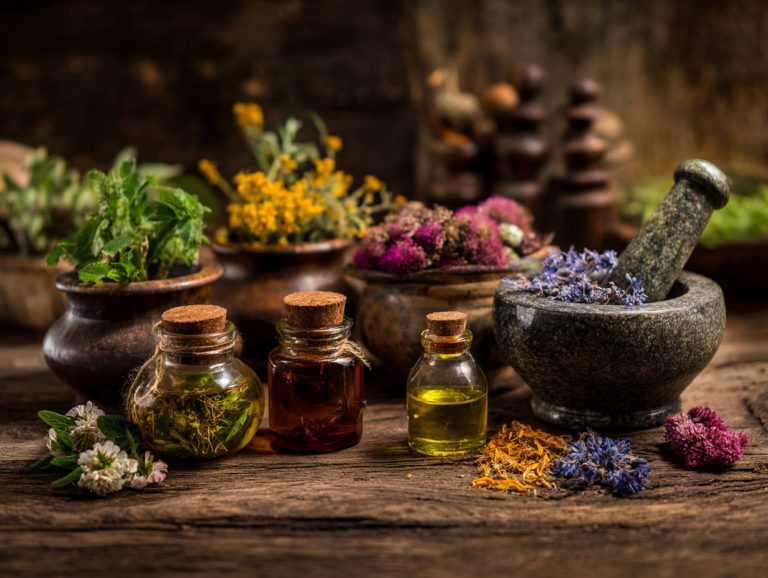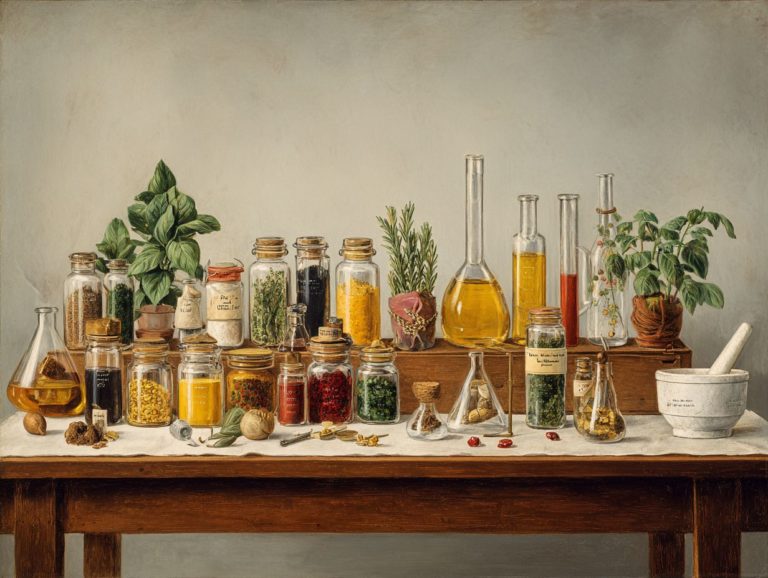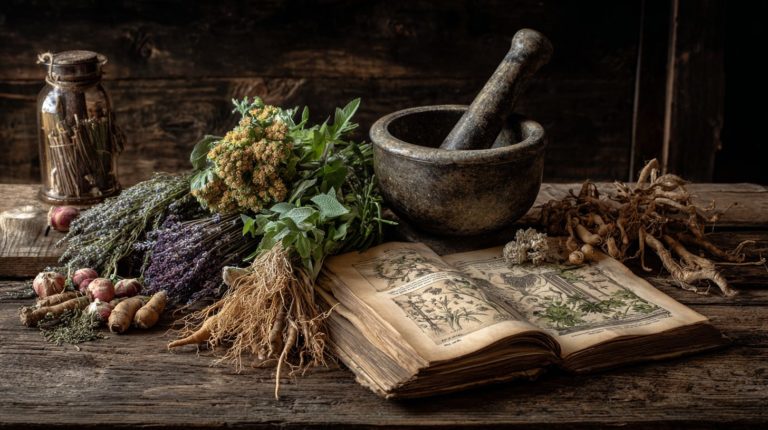Traditional Chinese Medicine: Principles, Practices, and Core Concepts
Traditional Chinese Medicine (TCM) is a complete healthcare system based on ancient Chinese philosophy, focusing on keeping the body in balance and harmony.
With its foundations in the principles of Yin and Yang, the Five Elements, and Qi, TCM offers a unique approach to health and wellness.
This overview covers important practices, such as acupuncture, herbal medicine, and dietary recommendations, while highlighting the core concepts that define TCM.
It discusses the benefits and potential risks connected to this long-established medical approach, offering information about its place in current health care.
Key Takeaways:
Contents
- 1 What is Traditional Chinese Medicine?
- 2 What are the Principles of Traditional Chinese Medicine?
- 3 What are the Practices of Traditional Chinese Medicine?
- 4 What are the Core Concepts of Traditional Chinese Medicine?
- 5 What are the Benefits of Traditional Chinese Medicine?
- 6 Traditional Chinese Medicine Usage Among Chinese Older Adults
- 6.1 TCM Usage Statistics: TCM Usage
- 6.2 TCM Usage Statistics: Health and TCM Use
- 6.3 TCM Usage Statistics: Prevalence of CAM in US
- 6.4 TCM Usage Statistics: TCM Usage in Demographics
- 6.5 TCM Usage Statistics: Prescribed vs. OTC Oral Herbal Products
- 6.6 1. Addresses Root Causes
- 6.7 2. Fewer Side Effects
- 6.8 3. Integrative with Western Medicine
- 7 What are the Potential Risks of Traditional Chinese Medicine?
- 8 Frequently Asked Questions
- 8.1 What is Traditional Chinese Medicine?
- 8.2 What are the principles of Traditional Chinese Medicine?
- 8.3 What are the practices of Traditional Chinese Medicine?
- 8.4 How does Traditional Chinese Medicine view the body and health?
- 8.5 What are some core concepts of Traditional Chinese Medicine?
- 8.6 Is Traditional Chinese Medicine effective?
What is Traditional Chinese Medicine?

Traditional Chinese Medicine (TCM) is a health practice that has been used for thousands of years. It works to improve health using methods like acupuncture, herbal remedies, and exercises that focus on the body and mind to bring back balance and support well-being.
This approach looks at the link between physical health, emotions, and the environment. It believes that many illnesses come from imbalances in the body’s main energies, called qi, which need to be balanced for effective healing. This aligns with findings from Britannica, which provides a detailed description and history of Traditional Chinese Medicine, supporting the holistic view of health.
What are the Principles of Traditional Chinese Medicine?
The basic ideas of Traditional Chinese Medicine (TCM) include important concepts that help in diagnosing and treating. They focus on the balance of yin and yang, the theory of five elements, and the movement of qi (life-force energy) in the body.
These ideas help TCM practitioners understand how the body’s systems are connected, looking at both physical and emotional aspects in their approach to diagnosis and treatment.
1. The Principle of Yin and Yang
The principle of yin and yang in Traditional Chinese Medicine represents the dual forces that govern all natural phenomena, emphasizing the need for balance between opposing elements to promote health and prevent illness.
Knowing this balance is important in diagnosing health issues, as practitioners think that an imbalance between yin, which stands for rest, nourishment, and cooling, and yang, which stands for activity, stimulation, and warmth, can cause different illnesses.
For instance, conditions such as insomnia may result from excess yang energy, while digestive issues might stem from a deficiency of yin. TCM treatments focus on bringing balance with techniques like acupuncture, herbal medicines, and changes in diet, tackling the cause of discomfort instead of only relieving symptoms.
By learning about these patterns, people can work towards full wellness, ensuring both energy forces are balanced in their bodies. For a deeper understanding, Cambridge offers a critical examination of the unique value of Yin-Yang balancing, highlighting the importance of this ancient philosophy in modern health practices.
2. The Principle of Five Elements
The five-element theory in Traditional Chinese Medicine groups different parts of nature into five categories: wood, fire, earth, metal, and water. Each group is linked to certain organs and emotions, helping to explain how body functions relate to health.
These components often impact body organs like the liver, heart, spleen, lungs, and kidneys, as well as feelings such as anger, joy, worry, sadness, and fear.
Wood is related to the liver and feelings of anger, while fire is associated with the heart and feelings of happiness.
TCM practitioners use this theory to diagnose and treat by identifying imbalances, which can show up as health problems like stress-related sicknesses or digestive issues. According to Healthline’s exploration of Five Element Theory, these treatments aim to restore balance and harmony.
By harmonizing these elemental relationships through acupuncture, herbal remedies, and lifestyle adjustments, individuals can experience improved health and emotional stability.
3. The Principle of Qi
Qi, or life-force energy, is a key idea in Traditional Chinese Medicine. It stands for the essential energy that moves through the body’s energy pathways, affecting physical health and emotional well-being.
This energy is thought to be essential for keeping balance and harmony in the body; when qi is plentiful and moving without obstruction, people often feel energetic and strong.
When qi stagnation occurs, it can lead to various health issues, including chronic pain, fatigue, and emotional disturbances like anxiety or depression.
To check qi movement, practitioners might look at symptoms, check the pulse, and examine the tongue.
Methods such as acupuncture, tai chi, and medicinal herbs can effectively restore balance, enhancing the movement of qi and promoting overall well-being.
Learning about qi can help people manage their health and reach a balanced state.
What are the Practices of Traditional Chinese Medicine?
Traditional Chinese Medicine (TCM) uses various methods to help people achieve good health and balance. These include acupuncture, herbal treatments, body therapies, and nutritional advice.
These methods focus on tackling the main causes of health problems by applying old knowledge to improve both physical and mental well-being. Acupuncture, for instance, is known for its role in pain relief and its effectiveness in treating various conditions.
1. Acupuncture
Acupuncture is a key practice in Traditional Chinese Medicine that involves inserting thin needles into specific points along the body’s energy channels to stimulate qi flow and restore balance.
This old method, which started more than 2,500 years ago, is known for helping with physical pain and also improving emotional health and reducing stress.
Acupuncture works by focusing on specific points connected to different organ systems. This helps release endorphins and increases blood flow, offering a full approach to pain management.
Emerging scientific research supports the efficacy of acupuncture in treating conditions like anxiety and depression by addressing the body’s stress response.
As both a time-honored and evidence-based practice, acupuncture presents a unique blend of historical depth and contemporary relevance.
2. Herbal Medicine
Herbal medicine in Traditional Chinese Medicine uses different plant-based materials, called Chinese herbal remedies, to treat health issues by bringing balance to the body’s systems.
These remedies encompass a range of herbs, roots, and flowers, each selected for their unique properties and energetic qualities.
Ginseng is often used to increase energy and help the immune system. Chrysanthemum is known for its cooling effects and is commonly used to lower fever and decrease swelling.
These formulations work to balance the body’s energies and align the five basic elements to improve health.
It’s important to talk to an experienced TCM practitioner who can customize treatments to fit personal diagnoses, making sure remedies are both safe and work well.
3. Massage and Manipulation
Bodywork, such as massage, is a key part of Traditional Chinese Medicine that involves working with the body’s soft tissues to improve energy health and encourage relaxation.
This complete method includes practices like tui na, acupressure, and shiatsu, each aimed at restoring balance and helping the flow of qi, or life energy, through the body.
Using specific approaches, these methods relax muscles, increase flexibility, and support emotional health, aiding individuals in managing anxiety and stress.
These bodywork methods improve physical health and general well-being. They increase awareness and strengthen the body connection, helping healing in various ways.
By examining how physical and emotional states relate, practitioners use these bodywork methods to support general well-being, making them important techniques in Traditional Chinese Medicine.
4. Diet and Nutrition
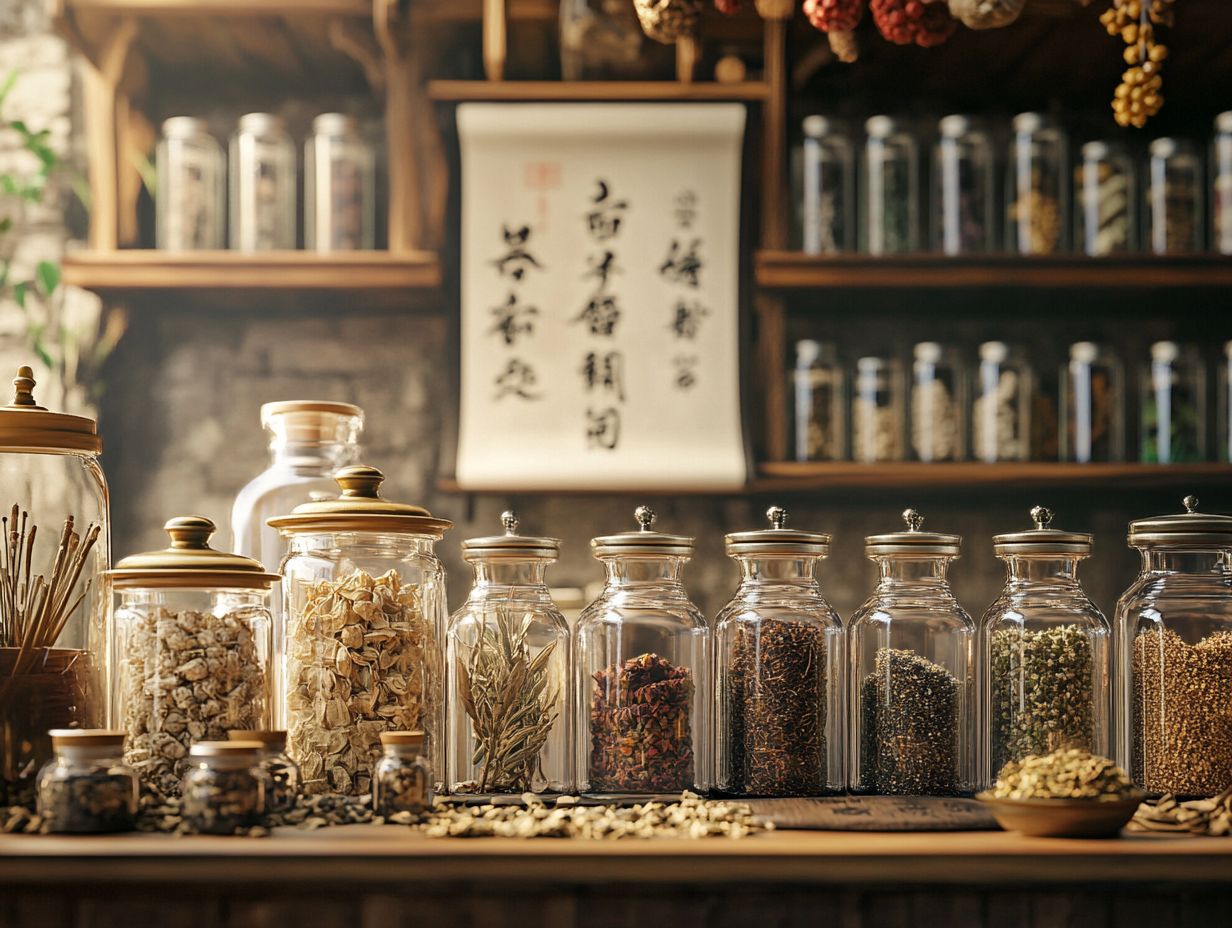
Diet and nutrition are important in Traditional Chinese Medicine, focusing on eating foods that suit a person’s natural body type and support good health.
In this approach, diet is seen not just as food, but as an important part that can affect the movement of qi, the essential energy thought to move through the body.
By choosing foods based on the yin-yang and five-element theory-wood, fire, earth, metal, and water-people can manage their energy better. For instance, including warming foods like ginger and cinnamon can increase yang energy, while cooling herbs such as mint and cucumber can support yin energy.
This careful selection helps maintain balance in the body, possibly correcting different issues and improving general health.
What are the Core Concepts of Traditional Chinese Medicine?
Traditional Chinese Medicine (TCM) focuses on treating the entire person. Its goal is to maintain body balance, prevent diseases, and provide customized care to address the underlying causes of health issues.
1. Holistic Approach
Traditional Chinese Medicine considers the body, mind, and surroundings as a linked system. This approach helps in treating patients by addressing the root causes of health problems.
This method encourages doctors to view each patient uniquely, considering their feelings, physical well-being, and environment rather than only looking at symptoms.
Unlike the more reductionist strategies commonly found in Western medicine, which often focus on treating specific ailments in isolation, TCM emphasizes the importance of balancing internal energies and harmonizing bodily functions.
This detailed approach enables a treatment plan that can involve acupuncture, herbal medicine, and changes to diet, helping to see health as a balance between different parts of life.
This method goes beyond just easing symptoms. It helps improve general health and stops health problems from happening later.
2. Balance and Harmony
Balance and harmony are central tenets of Traditional Chinese Medicine, reflecting the belief that health is achieved when the body’s energies are in a state of equilibrium.
TCM practitioners focus on identifying and fixing issues caused by factors such as lifestyle choices, emotions, and the movement of essential energy, known as Qi.
By assessing a patient’s overall well-being, they can develop individualized treatment plans that may include acupuncture, herbal remedies, and dietary recommendations.
These practitioners know that emotional well-being is important for physical health; stress and negative feelings can disturb energy flow, causing illnesses.
Thus, maintaining emotional balance is an important part of TCM, supporting both physical health and mental clarity, and leading patients to a healthier and more balanced life.
3. Prevention and Maintenance
Prevention and maintenance are fundamental aspects of Traditional Chinese Medicine, focusing on proactive measures to maintain health and prevent the onset of diseases.
For best health, people can use various TCM methods in their daily routines.
Lifestyle counseling is important, helping individuals make informed decisions about physical activity, rest, and managing stress.
Tools for managing stress, like mindfulness exercises and tai chi, are suggested to help control emotions and find inner calm.
Dietary guidance highlights the importance of consuming foods that fit your unique requirements, encouraging a customized eating approach.
Seeing a TCM practitioner regularly allows for a complete review of your health. This helps make timely changes to treatment plans and supports a full view of well-being.
4. Individualized Treatment
Traditional Chinese Medicine provides treatment that is specific to each person’s body type, health issues, and way of living.
This approach, called differential diagnosis, is essential for creating personalized treatment plans. It addresses the primary health issue rather than just relieving symptoms.
Practitioners assess various factors, including pulse quality, tongue appearance, and patient history, to understand the imbalances in the body.
For instance, two patients presenting with fatigue may undergo starkly different treatments; one may require nourishing herbal formulas to replenish energy levels, while the other might benefit from acupuncture aimed at improving circulation and relieving stress.
Traditional Chinese Medicine considers each person’s unique condition to improve their health and maintain wellness. It applies a personalized approach.
What are the Benefits of Traditional Chinese Medicine?
Traditional Chinese Medicine (TCM) has many benefits. It tackles the main causes of health issues, tends to have fewer side effects than many standard treatments, and works well alongside Western medicine.
Traditional Chinese Medicine Usage Among Chinese Older Adults
Traditional Chinese Medicine Usage Among Chinese Older Adults
TCM Usage Statistics: TCM Usage
TCM Usage Statistics: Health and TCM Use

TCM Usage Statistics: Prevalence of CAM in US
TCM Usage Statistics: TCM Usage in Demographics
TCM Usage Statistics: Prescribed vs. OTC Oral Herbal Products
Traditional Chinese Medicine Usage Among Chinese Older Adults Shows the widespread use of Traditional Chinese Medicine (TCM) among older adults in China and how it is combined into healthcare practices, pointing out patterns and demographic details. The data shows that many people use TCM on its own and together with regular Western medicine.
TCM Usage Statistics show that 76% of Chinese older adults have used TCM in the past year, matching the percentage of Western doctors in China incorporating TCM into their practices. This parallel suggests an integrative approach to healthcare, merging traditional methods with modern medical practices.
- Health and TCM Use: The reported odds ratios indicate varied impacts of TCM practices on health outcomes. Acupuncture shows a positive association with better health outcomes (OR = 1.33), while massage therapy also correlates positively with health status (OR = 1.53). Conversely, herbal products (OR = 0.69) and Tai Chi (OR = 0.62) seem to have a smaller effect on bettering quality of life, indicating that the effectiveness may vary with different treatments.
- Prevalence of CAM in the US: Complementary and Alternative Medicine (CAM) is used by 40% of Americans, with a higher prevalence among Asian older adults at 48.6%. This data reflects cultural influences and openness to alternative therapies within diverse communities.
- TCM Usage in Demographics: Among Chinese-American adults, 63% report lifetime use of TCM. Usage is notably higher among young older adults (77.7%) and Chinese older women (79.4%), indicating age and gender as significant factors in TCM adoption.
- Prescribed vs. OTC Oral Herbal Products: Over-the-counter (OTC) oral herbal products are used by 35.5% of individuals, significantly more than prescribed variants at 10.8%. This difference may point to accessibility and preference for self-directed healthcare choices.
The data presented in Traditional Chinese Medicine Usage Among Chinese Older Adults illustrates the entrenched role of TCM in healthcare for this demographic. It highlights the balancing act between traditional practices and modern medicine, emphasizing the need for ongoing research to understand the efficacy and integration of TCM in promoting health and well-being.
1. Addresses Root Causes
One of the main benefits of Traditional Chinese Medicine is its focus on treating the underlying causes of health problems rather than just reducing symptoms.
This method lets practitioners customize treatments using specific diagnostic techniques, especially pulse and tongue checks, which provide details about a person’s health.
For instance, pulse diagnosis can indicate issues related to blood circulation or digestive function, while the appearance of the tongue can highlight imbalances in organ systems or the presence of toxins.
Long-term health improvement can be achieved by addressing the root causes of chronic fatigue, digestive problems, and anxiety rather than just providing short-term relief.
2. Fewer Side Effects
Traditional Chinese Medicine often leads to fewer side effects than many Western treatments, providing a safer choice for patients looking for health solutions.
The gentle nature of herbal remedies and acupuncture highlights this benefit, as these methods focus on restoring balance and supporting overall health rather than just easing symptoms.
Patients often find that, unlike conventional therapies-which can lead to significant adverse reactions such as gastrointestinal distress or hormonal imbalances-TCM offers a more harmonious approach to health.
Using natural herbs that help the body’s natural healing and acupuncture methods that improve energy flow, many people share a better healing experience, strengthening trust in TCM as a complete approach to health that lowers risks while treating various illnesses.
3. Integrative with Western Medicine
Traditional Chinese Medicine can work well with Western medicine. Together, they can improve patient care and overall health.
This complete model gives patients the advantages of both systems, as shown by many case studies with successful results.
For instance, in treating chronic pain, individuals have reported significant improvements when acupuncture is combined with conventional pain management therapies.
Clear and open communication between TCM practitioners and Western healthcare providers is necessary for patient safety and to improve care plans.
By working together, healthcare teams can customize treatments to meet each patient’s specific needs, resulting in more complete and effective healing processes.
What are the Potential Risks of Traditional Chinese Medicine?
Traditional Chinese Medicine can be helpful in many ways, but there are some risks.
These include:
- Contaminated or mislabeled herbs
- No strict rules to follow
- Possible harmful reactions to herbal remedies
For an extensive analysis of pain relief techniques within Traditional Chinese Medicine, our comprehensive study on acupuncture examines its effectiveness and usage.
1. Contamination or Mislabeling of Herbs
One significant risk in Traditional Chinese Medicine is the potential for contamination or mislabeling of herbal remedies, which can lead to ineffective treatments or harmful side effects.
This issue concerns consumer safety and raises doubts about the reliability of herbal treatments in healthcare.
If products are not properly monitored, patients might take substances that haven’t been shown to work and could interact harmfully with other medicines.
To lower these risks, we need stricter rules and quality checks. Herbal products should undergo detailed testing to confirm their purity and authenticity. Organizations like the World Health Organization and national health agencies should collaborate to establish regulations that hold manufacturers accountable for their products. This is intended to protect consumers and increase confidence in Traditional Chinese Medicine.
2. Lack of Regulation and Standardization
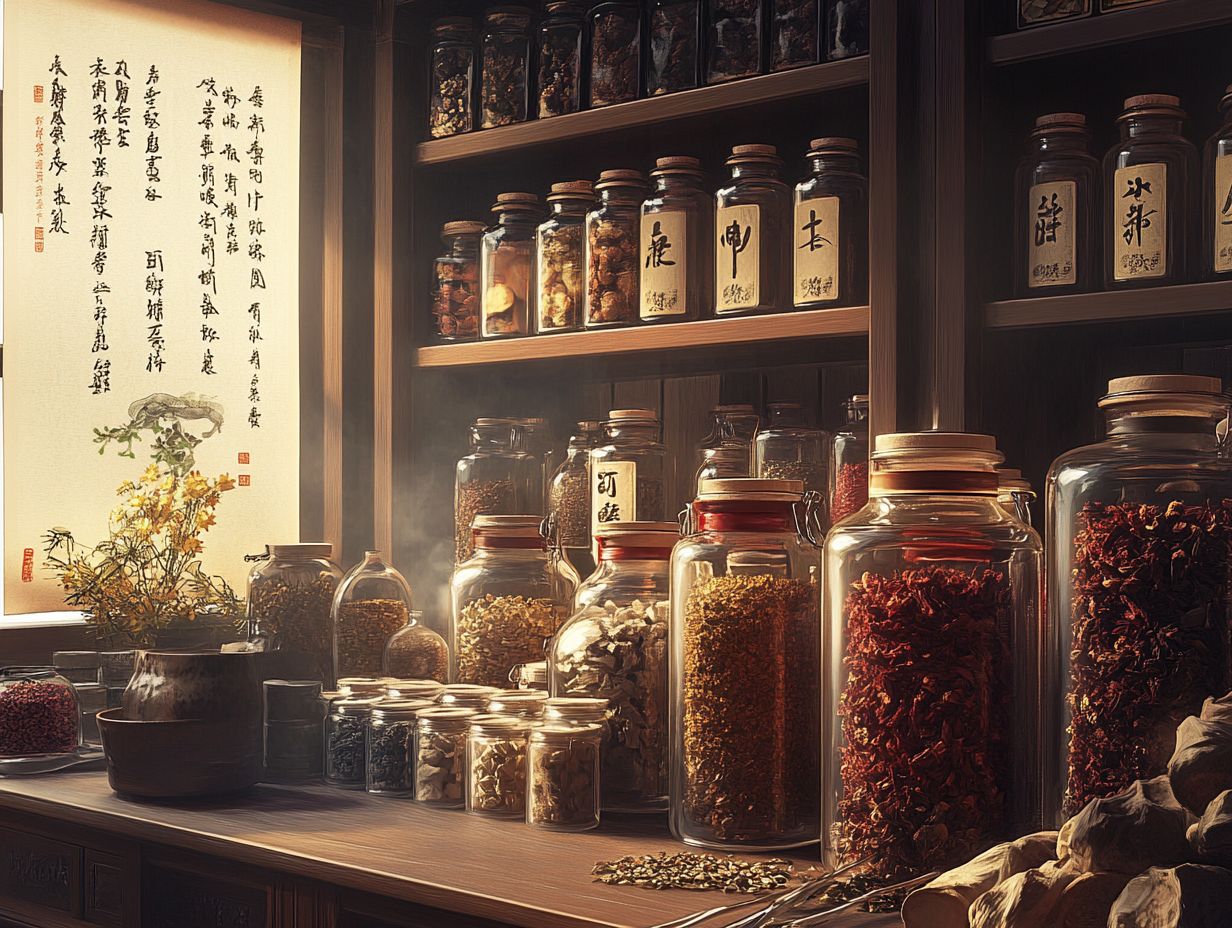
The absence of rules and consistency in Traditional Chinese Medicine can create problems for patients trying to find treatments that are both safe and effective.
This uncertainty often leads individuals to question the efficacy and safety of various herbal remedies and acupuncture techniques available in the market. Without stringent oversight, practitioners may not adhere to established protocols, resulting in a wide disparity in the quality of care.
People interested in TCM should find practitioners with the necessary training and certification. Selecting reputable products from trusted sources can significantly mitigate potential risks associated with poorly formulated herbal compounds or unsafe practices.
Patients should advocate for their health by ensuring that the practitioners and products they choose abide by recognized standards and regulations in the field.
3. Adverse Reactions to Herbs
Patients might have negative responses to specific herbs used in Traditional Chinese Medicine, showing the need for individualized treatment and expert advice.
These reactions can vary from minor stomach issues to serious allergic reactions, highlighting the need for a thorough and correct diagnosis before starting any herbal treatment.
People should consult experienced TCM practitioners who can assess their individual health problems and histories. By doing this, practitioners can create individualized treatment plans that address specific health issues and consider possible conflicts and interactions with other medications.
Effective communication and thorough evaluations are key to promoting safe and effective use of herbal remedies while minimizing risks associated with misuse.
4. Possible Interactions with Other Medications
There is a risk of possible interactions between Traditional Chinese Medicine treatments and other medications, necessitating thorough communication between patients and healthcare providers.
Patients should give a complete list of everything they are taking, such as over-the-counter medicines and herbal products. This openness is important because interactions can cause harmful effects, make treatments less effective, or even lead to risky health issues.
For example, using herbs like St. John’s Wort with prescription antidepressants can cause serotonin syndrome, a serious problem due to too much serotonin in the body. By frequently discussing and adjusting treatments, healthcare providers can improve safety and effectiveness, resulting in better patient care.
Frequently Asked Questions
What is Traditional Chinese Medicine?
Traditional Chinese Medicine, or TCM, is a way of healthcare that has been used for thousands of years in China. It is based on the principles of balance and harmony, and focuses on treating the root cause of illness rather than just the symptoms.
What are the principles of Traditional Chinese Medicine?
The core principles of TCM are Yin and Yang, Qi, and the Five Elements. Yin and Yang symbolize the balance between opposite forces, Qi is the essential energy moving through the body, and the Five Elements are the various natural elements that affect health and well-being.
What are the practices of Traditional Chinese Medicine?
The main practices of TCM include acupuncture, herbal medicine, massage, and dietary therapy. Acupuncture involves the use of thin needles to stimulate specific points on the body, while herbal medicine uses natural ingredients to restore balance and promote healing. Massage and dietary therapy are also used to support overall health and well-being.
How does Traditional Chinese Medicine view the body and health?
In TCM, the body is seen as a complex system that is connected to the environment and the mind. Health is viewed as a state of balance and harmony between the body, mind, and environment. When this balance is thrown off, sickness and health problems can happen.
What are some core concepts of Traditional Chinese Medicine?
Besides the principles of Yin and Yang, Qi, and the Five Elements, other main ideas of TCM include the meridian system, which is thought to be the paths of Qi in the body, and the idea that the body reflects the universe, where everything is connected and affects each other.
Is Traditional Chinese Medicine effective?
While more research is needed, TCM has been shown to be effective in treating a variety of health conditions, including chronic pain, digestive issues, and mental health disorders. It is also known to promote overall well-being and can be used as a preventive measure to maintain health and balance in the body.

Sheetal Sharda has a background in CS. She got an interest in Holistic living back in 2018, and has since started exploring more into Naturapathy, Holistic Living, Yoga, and more. She got inspired to start SereneClinics to help people find reliable centers across the world.
